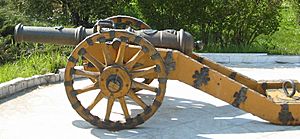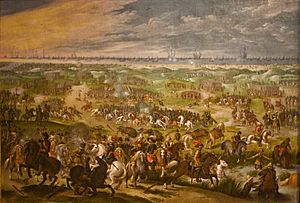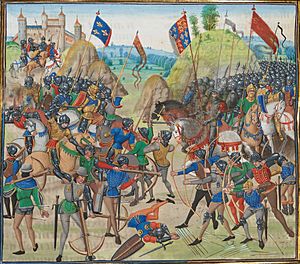Military history facts for kids
Military history is the story of how people have fought wars and conflicts throughout time. This can include anything from a small fight between two groups to a huge world war. Military historians are people who study and record these events.
Contents
How Technology Changed Warfare
New weapons and tools can completely change how wars are fought. They can affect how much wars cost, how armies prepare, and how soldiers are trained. If an enemy has a powerful new weapon, an army usually needs to either get a similar one or find a way to stop it.
Ancient Times
Chariots were first used around 2000 BC. They were fast and effective weapons. One person drove the chariot, while another shot arrows at enemies. Chariots were very important for powerful governments like the New Egyptian Kingdom and the Shang Dynasty.
Some military units and technologies from ancient times include:
- Slingers (who threw stones)
- Hoplites (Greek foot soldiers)
- Infantry (foot soldiers)
- Archery (using bows and arrows)
- Crossbowmen (using crossbows)
- Cavalry (soldiers on horseback)
For farming civilizations, foot soldiers became the main part of the army. The Greeks and early Romans used tight, heavily armed groups called phalanxes. The Romans later used more flexible groups called maniples, which helped them win many battles.
Cavalry (soldiers on horseback) became very important. In the Second Punic War, Hannibal's cavalry was key at the Battle of Cannae. Alexander the Great also used his cavalry well to win battles.
There were also horse archers, who could shoot arrows while riding. Groups like the Parthians and Mongols were famous for this skill. Later, heavily armored cavalry became common.
War elephants were sometimes used in ancient battles. They were first used in India and later by the Persians and Alexander the Great. Hannibal also used war elephants against the Romans.

Naval warfare (fighting at sea) was often vital for success. Early navies used ships powered by oars, often with slaves. The goal was usually to ram enemy ships to sink them. Galleys were used by the Cretans around 3000 BC.
The first recorded naval battle was in 1210 BC between the Hittites and Cyprus. In the Persian Wars, navies became even more important. Triremes, which were advanced Greek warships, were used in complex sea battles. Themistocles built a strong Greek navy that defeated the Persians at the Battle of Salamis.
In the First Punic War between Carthage and Rome, Carthage had more naval experience. Rome built its own fleet and added a special bridge called a corvus. This bridge allowed Roman soldiers to board enemy ships, helping them win the Battle of Mylae.
Fortifications (defensive structures) were also very important. Early hill-forts protected people in the Iron Age. They were simple forts surrounded by ditches. Later, forts were built from mud bricks, stones, and wood. The Romans built strong rectangular fortresses. To capture forts, armies often had to lay siege to them, meaning they surrounded them and tried to break in.
Middle Ages
Some military units and technologies from the medieval period include:
- Artillery (large guns or cannons)
- Knights (armored horsemen)
- Crossbows
- Pikemen (soldiers with long spears)
- Samurai (Japanese warriors)
- Trebuchets (large siege weapons)
Bows and arrows were widely used. The crossbow was developed in China around 500 BC and became very popular in the Middle Ages. The English/Welsh longbow, from the 12th century, was also important. It gave the English a big advantage in the Hundred Years' War, helping them win battles like Crécy and Agincourt.
The Rise of Gunpowder

In the 10th century, the invention of gunpowder changed warfare forever. Black powder was used in China since the 4th century, but it became a weapon in the 11th century. Early guns were lit by hand. Later, the matchlock was invented, which made guns easier to fire. This was replaced by the flintlock later on.
Cannons were first used in Europe in the early 14th century and were very important in the Hundred Years' War. The first cannons were simple metal tubes, and their cannonballs were made of stone.
In the early 16th century, fire ships were used. These were ships filled with flammable materials, set on fire, and sent towards enemy lines. Francis Drake used this tactic successfully against the Spanish Armada.
Naval mines were invented in the 17th century. They were used more widely in the American Civil War and heavily in the First and Second World Wars.
The first working submarine was built in 1624. However, the first military submarine was built in 1885 by Isaac Peral. The Turtle was developed during the American Revolution.
The Howitzer, a type of field artillery, was developed in the 17th century. It could fire explosive shells in a high arc to hit targets that flat-shooting cannons couldn't reach.
Armies also started using bayonets, which are knives attached to the end of a rifle. They were used for hand-to-hand combat.
Balloons were first used in warfare in the late 18th century. They allowed military scouts to see enemy movements from high in the sky, making it harder for armies to hide.
In the late 18th century, artillery rockets were used in India against the British. These early rockets were not very accurate, but they improved over time.
In the 1860s, rifles saw many improvements. The first repeating rifles were designed, and machine guns appeared in the late 19th century. Automatic rifles and light machine guns came out in the early 20th century.
The self-propelled torpedo was developed in the later 19th century.
Modern Technologies
At the start of the World Wars, new weapons surprised many armies. Flame throwers were first used in the First World War. The French introduced the armored car in 1902. Later, the British created the first armored troop carrier.
Early tanks were experimental, but they became very important. In World War I, the British and French had many more tanks than the Germans, giving them a big advantage.
On December 17, 1903, the Wright Brothers made the first controlled flight. By World War I, aviation became important, and pilots became famous. This led to the development of aircraft carriers, which are ships that planes can take off from and land on.
Chemical warfare (using poison gas) was used in World War I. The Germans used chlorine gas in April 1915. However, gas masks were quickly invented, and poison gas did not win battles. It was made illegal by many nations in the 1920s.
World War II brought even more technology. The aircraft carrier proved its worth in battles like the Battle of Midway. Radar was invented, which used radio waves to detect objects. Molotov cocktails (simple firebombs) were used in the Spanish Civil War. The atomic bomb was developed and dropped on Hiroshima and Nagasaki in 1945, quickly ending World War II.
During the Cold War, powerful countries like the US and Soviet Union had a Nuclear arms race, building many nuclear weapons. The space race also led to new technologies like spy satellites and powerful ballistic missiles. Nuclear submarines were invented in 1955, allowing submarines to stay underwater for much longer and carry missiles.
Periods of Military History
Military historians often divide history into different periods based on big changes, especially in technology.
Ancient Warfare
Much of what we know about ancient history comes from studying militaries. Kingdoms and empires in the ancient world needed military force to stay in power. Also, weapons and armor were built to be strong, so they often survived longer than other objects.
Ancient writings often focused on military conquests and victories. Major battles were big events that people wanted to record in stories, poems, and histories.
Important ancient militaries included the Egyptians, Persians, Greeks (like the Spartans and Macedonians), Indians, and Romans.
The Fertile Crescent in Mesopotamia saw many conquests by groups like the Sumerians, Babylonians, and Assyrians. Iranians were the first to use cavalry in their army.
Egypt was a powerful ancient nation but was eventually conquered by many different groups.
In India, the Indian epics Mahabharata and Ramayana tell stories of conflicts and warfare. Chanakya's Arthashastra also describes ancient warfare, including espionage and war elephants. Alexander the Great invaded India, but later Chandragupta Maurya unified much of Northern India.
In China, the Warring States period saw many states fighting each other. Philosophers like Sun Tzu wrote about warfare. The Qin Shi Huang unified these states, creating the first Chinese empire. The Han Dynasty later expanded this empire.
The Achaemenid Persian Empire was founded by Cyrus the Great. It became a huge empire but later fell to Alexander the Great.
In Greece, city-states like Athens and Sparta became powerful. The Greeks stopped two Persian invasions, including the famous naval battle at Salamis. The Peloponnesian War then broke out between Athens and Sparta.
Meanwhile, Rome grew powerful. In the three Punic Wars, the Romans defeated Carthage. The First Punic War was mostly about naval battles. In the Second Punic War, Hannibal invaded Italy by crossing the Alps and won the Battle of Cannae. But he was later defeated by Scipio at the Battle of Zama.
After defeating Carthage, Rome became the main power in the Mediterranean. They won many campaigns in Greece and the Middle East. Roman armies were well-trained and organized, which helped them defeat larger enemy armies.
However, Rome also had many civil wars. Famous generals like Gaius Julius Caesar fought for power. Eventually, Rome became an empire with a large professional army.
By the time of Marcus Aurelius, the Roman Empire was very large. But it soon began to decline. Groups like the Huns and Goths invaded Rome, and the western part of the empire eventually collapsed in 476 AD. The Byzantine Empire in the east continued to thrive.
Medieval Warfare
During the Middle Ages, feudalism was common in Europe. Landlords often owned castles to protect their lands.
The Islamic Arab Empire expanded rapidly across the Middle East, North Africa, and Central Asia. They were stopped from invading Europe by Byzantium and Bulgaria. The Franks under Charles Martel also stopped a Muslim invasion at the Battle of Tours. The Arab Empire eventually ended after the Battle of Baghdad in 1258.
In China, the Sui Dynasty and later the Tang Dynasty fought with various groups. The Song Dynasty invented new weapons using gunpowder.
The Mongols under Genghis Khan and Kublai Khan conquered most of Asia and parts of Europe. They created a huge empire that stretched across Eurasia.
In New Zealand, before Europeans arrived, Māori warriors were highly respected. Another group, the Moriori, developed a peaceful culture. When mainland Māori invaded their islands in the 1830s, the Moriori could not defend themselves and were enslaved or killed.
Gunpowder Warfare

After gunpowder weapons were developed in China, the technology spread west. The arquebus, an early type of rifle, was adopted by European armies in the early 16th century. This ended the time when armored cavalry ruled the battlefield.
The decline of the feudal system also led to the creation of professional standing armies. These armies replaced the part-time soldiers and mercenaries of the Middle Ages.
In Africa, Ahmad ibn Ibrahim al-Ghazi was the first African commander to use gunpowder in the Ethiopian–Adal War.
Between 1648 and 1789, wars in Europe were often fought by kings and queens with professional armies. These wars were usually limited in their goals.
Over the 18th and 19th centuries, military forces changed a lot. Field artillery became more mobile, and the rifle replaced the musket.
Industrial Warfare
As weapons became easier to use, countries started using conscription, which means drafting ordinary citizens into the army. This greatly increased the number of soldiers available. Napoleon Bonaparte famously used conscription. It was also used by almost all sides in the two World Wars.
Total war became a concept in industrial warfare. This meant trying to prevent the enemy nation from being able to fight at all. Examples include William Tecumseh Sherman's "March to the Sea" in the American Civil War and the bombing of cities and factories in World War II.
Modern Warfare
In modern times, war has become a scientific enterprise. Militaries have developed amazing technologies, funded by governments. What makes modern military organizations different is the huge variety of tools and methods available to commanders. These range from submarines to satellites, and from knives to nuclear warheads.
Images for kids
-
The Canadian War Museum.
-
A painting by Sebastiaen Vrancx showing a battle from the Eighty Years' War.
See also
 In Spanish: Historia militar para niños
In Spanish: Historia militar para niños









